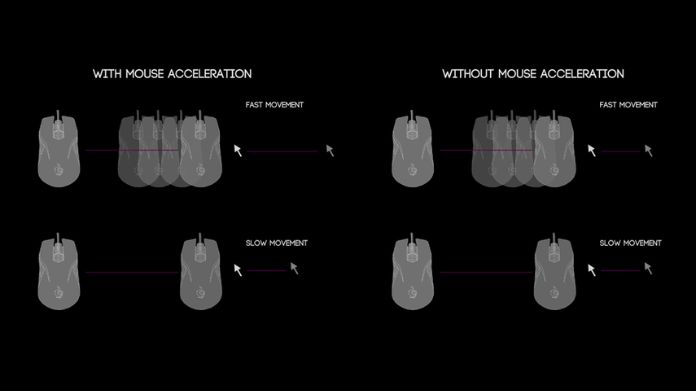Ever felt like your cursor isn’t keeping up with your pace, or maybe it’s sprinting ahead? This could be due to your mouse acceleration settings.
Adjusting these settings can transform your interaction with your computer, whether you’re deep into gaming, fine-tuning a design, or simply navigating your desktop.
In this guide, Okayreview will walk through the steps to fine-tune your mouse acceleration, ensuring your cursor moves just the way you like.
Ready to take control? Let’s start mastering your mouse settings for a seamless computing experience.
Table of Contents
What is Mouse Acceleration?
Mouse acceleration, my dear reader, is like that well-meaning friend who tries to help but ends up making things more complicated.
It’s supposed to make your cursor mirror the speed of your mouse movement – move it slowly, and your cursor takes a leisurely stroll across your screen.
Flick it fast, and your cursor sprints like it’s in the Olympics. Handy for vast screen real estate but a nightmare in precision-required tasks.
When is Mouse Acceleration a Good Idea?
Now, I’m not here to demonize mouse acceleration. It’s got its place. If you’re someone who’s more into casual browsing than headshots, or if your desk space is as cramped as a Tokyo subway, keeping it on might just be your ticket to comfort.
 Certainly! Here’s when you should consider keeping mouse acceleration enabled, presented in a point-style format:
Certainly! Here’s when you should consider keeping mouse acceleration enabled, presented in a point-style format:
- Limited Desk Space: Enables more screen navigation with less physical mouse movement, ideal for small workspaces.
- Familiarity: If you’re accustomed to mouse acceleration and it suits your workflow or gaming style, stick with it.
- Gaming Needs: Beneficial for games requiring quick navigation and rapid turns, mouse acceleration can enhance performance in fast-paced scenarios.
- Comfort: If disabling it makes your cursor control feel off or uncomfortable, keeping it enabled might be better for your overall experience.
- Efficiency: For general computing, if acceleration helps you work more efficiently across large screens or multiple monitors, keep it on.
Disabling and enabling mouse acceleration can vary depending on your operating system. Below, I’ll provide general instructions for Windows, macOS, and some Linux distributions:
How to Enable and Disable Mouse Acceleration?
For Windows:
Enable Acceleration:
- Follow the same steps to access the ‘Pointer Options’ tab in the Mouse Properties window.
- Check the box next to ‘Enhance pointer precision.’
- Tap on the ‘Apply’ and then ‘OK’ to save your changes.
Disable Acceleration:
- Navigate to the Control Panel and choose ‘Hardware and Sound.’
- Click on ‘Mouse’ under ‘Devices and Printers.’
- In the Mouse Properties window, switch to the ‘Pointer Options’ tab.
- Deselect the ‘Enhance pointer precision’ option.
- Hit ‘Apply’ followed by ‘OK’ to confirm your adjustment
For macOS:
Enable Acceleration:
- Open Terminal.
- Type the following command and press Enter: defaults write.GlobalPreferences com.apple.mouse.scaling 1 (You can replace ‘1’ with a higher number for more acceleration).
- Log out and log back in, or restart your computer.
Disable Acceleration:
- Open Terminal from your Applications > Utilities folder.
- Type the following command and press Enter: defaults write.GlobalPreferences com.apple.mouse.scaling -1
- You may need to log out and log back in or restart your computer for the changes to take effect.
Using Raw Accel:
“Raw Accel?” It’s a neat piece of software designed for those using Windows 10 or 11 who want to get more precision from their mouse – think gamers or designers needing that extra bit of control.
You can tweak a whole lot of settings to make your mouse move just the way you like it. Plus, it digs deep into your system for consistent performance and plays nice with gaming anti-cheat systems.
Whether you’re in a fast-paced game or crafting detailed designs, Raw Accel gives you the power to customize your mouse’s behaviour to fit your needs. And don’t worry; it’s user-friendly so that you won’t get lost in tech jargon.
To maximize mouse acceleration precision with Raw Accel, follow these simple steps:
- Get Raw Accel from the official website of Raw Accel, install it, and restart your computer.
- Open Raw Accel and get familiar with the settings.
- Experiment with sensitivity multipliers and acceleration curves.
- Try different settings to see what works best for your needs.
- Once satisfied, apply the changes and save your configuration.
Winding Up!
Whether you decide to keep mouse acceleration as a trusty sidekick or kick it to the curb, remember that it’s all about what works for you. Experiment, adjust, and find that sweet spot that makes your digital life a breeze.
Frequently Asked Questions
Q. What Exactly is Mouse Acceleration?
Ans. Imagine your mouse is a car. With mouse acceleration off, speed and distance are consistent – press the pedal (move the mouse), and you’ll predictably move a set distance. Turn it on, and suddenly, your car speeds up the faster you go, making precise stops a bit of a challenge.
Q. How Do I Turn Off Mouse Acceleration?
Ans. Dive into your control panel like a digital ninja, navigate to your mouse settings, and disable that “Enhance pointer precision” option. It’s like telling your mouse to calm down and take things slow.
Q. Why Would I Want to Disable Mouse Acceleration?
Ans. If you’re into gaming or any task requiring pinpoint accuracy, turning off mouse acceleration is like switching from a blunt to a sharp pencil. It just makes everything clearer and more precise.
Q. Can Mouse Acceleration Affect My Gaming?
Ans. Absolutely! With mouse acceleration on, your aim in games can become as unpredictable as a weather forecast. Turning it off can improve your aim by making movements more consistent and predictable.
Q. Is Mouse Acceleration a Universal Setting?
Ans. Nope, it varies from system to system and even from game to game. That’s why some gamers spend more time tweaking settings than actually playing. But finding the right setup can make all the difference in your digital adventures.


I enjoy how you broke down what mouse acceleration is, its pros and cons, and how it impacts gaming and everyday use. Your clear explanations and practical tips on adjusting settings make finding the right balance between precision and comfort easy.